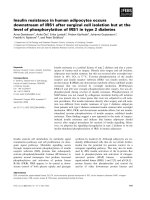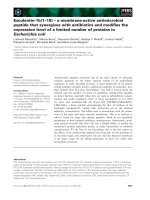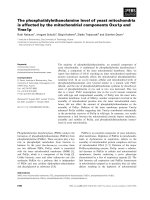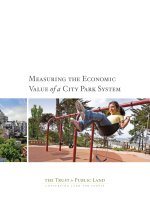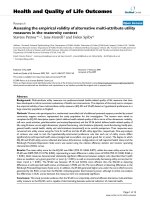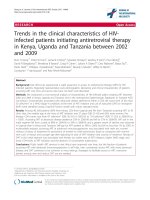Measuring the success level of public-private partnership transportation infrastructure projects in Vietnam using fuzzy topsis method
Bạn đang xem bản rút gọn của tài liệu. Xem và tải ngay bản đầy đủ của tài liệu tại đây (513.52 KB, 16 trang )
Transport and Communications Science Journal, Vol. 71, Issue 4 (05/2020), 403-418
Transport and Communications Science Journal
MEASURING THE SUCCESS LEVEL OF PUBLIC-PRIVATE
PARTNERSHIP TRANSPORTATION INFRASTRUCTURE
PROJECTS IN VIETNAM USING FUZZY TOPSIS METHOD
Le Dinh Thuc1, Pham Phu Cuong2*
1
Pukyong National University, 45 Yongso-ro, Namgu, Busan, South Korea
2
Campus in Ho Chi Minh City, University of Transport and Communications, 450 - 451 Le
Van Viet Street, Tang Nhon Phu A Ward, District 9, Ho Chi Minh City, Vietnam
ARTICLE INFO
TYPE: Research Article
Received: 26/3/2020
Revised: 17/5/2020
Accepted: 18/5/2020
Published online: 28/5/2020
/>*
Corresponding author
Email: ; Tel: (+84)0903.787.362
Abstract. Public–Private Partnership (PPP) has emerged as an effective procurement in
delivering infrastructure and public service in many countries over the world since last few
decades. It brought more benefits for sustainable development compared to traditional
procurement in many developing countries. However, in order to determine whether a project
is successful or not has still remained an ambiguous perception. Therefore, this study will
rank the successful level for PPP transportation infrastructure projects in Vietnam via case
studies. Fifteen success criteria were identified by the comprehensive review. The fuzzy
TOPSIS method was then applied to evaluate and rank the success level for case studies. The
result showed that project 2 is considered as the most successful until this recent time with a
satisfactory degree of 0.489. Project 1 and project 3 are ranked second and third with a
satisfactory degree of 0.482 and 0.435, respectively. Although the projects were judged as
effective. Nevertheless, the success index of these expressway project still lower than 0.5.
Therefore, project managers need to propose effective solutions to improve the success of
these projects in the future. This result can help participants to be a good insight into the PPP
project success in developing countries in general and Vietnam in particular.
Keywords: public-private partnership, transportation projects, success level, fuzzy TOPSIS,
Vietnam.
© 2020 University of Transport and Communications
403
Transport and Communications Science Journal, Vol. 71, Issue 4 (05/2020), 403-418
1. INTRODUCTION
Public–Private Partnership (PPP) has emerged as an effective procurement in delivering
infrastructure and public services in many developing countries since last few decades. PPP
form is a participation of both public and private parties in the project based on their expertise
with different levels of contribution and commitment in delivering public services effectively
[1]. The experience and knowledge of private sector were exploited via PPP investment [2].
PPP schemes brought advantages in procurement and risk-sharing between the parties [3]. In
Vietnam, a number of transportation projects, especially expressway projects have
implemented via PPP procurement since 1993 [4], which contributed to enhancing
infrastructure service and the economic market. Nevertheless, not all PPP projects are
successful. Many challenges have been occurred in some projects in developed and
developing countries. BOT transportation projects in Thailand, the Sydney Cross City
Tunnel, and the Betuwe Railway in the Netherlands were examples of the failure of PPP
procurement [5-7]. Therefore, many prior authors focused on several topics of the PPP market
such as risk management, critical success factors, value for money, economic feasibility,
government role, and concessionaire selection [8] However, studies on successful level of
PPP projects is scarce [9, 10]. In fact, it will be difficult for private and public sectors to
define whether their projects have been successful or not if success criteria are not considered
[11]. Therefore, this study will rank successful level for PPP transportation projects in
Vietnam via three expressway projects. This study will help both practitioners and researchers
to have an in-depth understanding of the criteria to make good decisions for the success of
PPP transportation projects in this country.
2. LITERATURE REVIEW
The definition of project success is complex [12]. It depends on project type and project
participants, etc [13]. Al-Tmeemy et al.[14] revealed that project success is a consensus of
project efforts and objectives of enterprises. Success is described as an intangible
measurement [15]. Determining whether a project is considered successful or not has still
remained an ambiguous perception [16]. In this context, Chan and Chan [13] concluded that a
successful project needs to adhere to specific principles to gain favorable outcomes. In
another context, PPP nature is more complex due to the huge amount of investment and longterm contractual periods [17]. Therefore, many authors have sought different ways to gain
success for PPP projects. Akintoye et al. [1] implied that there are differences in success
criteria between PPP projects and traditional projects. Tam [18] denoted that completion in
time and budget, service quality, well-structured agreement, and an equitable legal system as
important components for BOT project success in Southeast Asia. Yuan et al.[19] analyzed 15
successful objectives in PPP projects based on the opinions of different stakeholders.
Whereby, project quality, reliability service, and completion in the budget was ranked the top
three performance objectives in PPP projects. Similarly, Mladenovic et al. [20] established
two layers for performance evaluation of PPP transportation projects based on a
brainstorming approach. They revealed that PPP project success should be defined in the
accomplishment of the ultimate objectives of different stakeholders in the first stage,
including profitability, stakeholders’ satisfaction, value for money, effectiveness,
environmental influence, and level of service. The fulfillment of the performance objectives
of each stakeholder will be examined in the second stage for assessing whether the project is
successful or not. Romero and Liyanage [21] proposed 29 performance measures and 9 key
404
Transport and Communications Science Journal, Vol. 71, Issue 4 (05/2020), 403-418
performance indicators to define the success level in PPP road projects in Europe with testing
of 13 road projects in the UK, Spain, Belgium, Portugal, Netherlands, and Greece. In another
review, deriving from the international experts’ judgment from Hong Kong and Ghana, OseiKyei and Chan [11] collected 15 critical success criteria of PPP projects in which seven
success criteria are considered as very critical such as meeting standard output, adherence to
budget, adherence to time, profitability, effective risk management, service quality, and
environmental performance.
The concept of project success is diverse and ambiguous due to various perceptions [15].
Nevertheless, the contribution of previous studies regarding successful measurement for PPP
projects is limited [22]. The present study, therefore, enriches refer source of this topic by
identifying success criteria and evaluating project success via case studies in Vietnam.
3. RESEARCH METHODOLOGY
3.1. Identifying success criteria for PPP projects
A literature review relevant to success criteria in both traditional construction and PPP
projects has been carried out via the previous studies, by which 15 success criteria were
identified. To ensure the adequacy of this research, the obtained criteria were sent to a group
of five experts who had at least ten years of experience in PPP transport projects in Vietnam.
Each expert was asked to examine the suitability of success criteria for PPP transport projects
based on his/her experience. In this process, five experts agreed with most criteria, a few
criteria were accepted by some experts but not all. They then concentrated to judge these
criteria for accomplishing the list. Finally, total a list of 15 success criteria was adopted by the
consensus of five experts and no criteria were suggested to add to the list. They are presented
in Table���������������������������������������������������������������������������������������������������������������������������������������������������������������������������������������������������������������������������������������������������������������������������������������������������������������������������������������������������������������������������������������������������������������������������������������������������������������������������������������������������������������������������������������������������������������������������������������������������������������������������������������������������������������������������������������������������������������������������������������������������������������������������������������������������������������������������������������������������������������������������������������������������������������������������������������������������������������������������������������������������������������������������������������������������������������������������������������������������������������������������������������������������������������������������������������������������������������������������������������������������������������������������������������������������������������������������������������������������������������������������������������������������������������������������������������������������������������������������������������������������������������������������������������������������������������������������������������������������������������������������������������������������������������������������������������������������������������������������������������������������������������������������������������������������������������������������������������������������������������������������������������������������������������������������������������������������������������������������������������������������������������������������������������������������������������������������������������������������������������������������������������������������������������������������������������������������������������������������������������������������������������������������������������������������������������������������������������������������������������������������������������������������������������������������������������������������������������������������������������������������������������������������������������������������������������������������������������������������������������������������������������������������������������������������������������������������������������������������������������������������������������������������������������������������������������������������������������������������������������������������������������������������������������������������������������������������������������������������������������������������������������������������������������������������������������������������������������������������������������������������������������������������������������������������������������������������������������������������������������������������������������������������������������������������������������������������������������������������������������������������������������������������������������������������������������������������������������������������������������������������������������������������������������������������������������������������������������������������������������������������������������������������������������������������������������������������������������������������������������������������������������������������������������������������������������������������������������������������������������������������������������������������������������������������������������������������������������������������������������������������������������������������������������������������������������������������������������������������������������������������������������������������������������������������������������������������������������������������������������������������������������������������������������������������������������������������������������������������������������������������������������������������������������������������������������������������������������������������������������������������������������������������������������������������������������������������������������������������������������������������������������������������������������������������������������������������������������������������������������������������������������������������������������������������������������������������������������������������������������������������������������������������������������������������������������������������������������������������������������������������������������������������������������������������������������������������������������������������������������������������������������������������������������������������������������������������������������������������������������������������������������������������������������������������������������������������������������������������������������������������������������������������������������������������������������������������������������������������������������������������������������������������������������������������������������������������������������������������������������������������������������������������������������������������������������������������������������������������������������������������������������������������������������������������������������������������������������������������������������������������������������������������������������������������������������������������������������������������������������������������������������������������������������������������������������������������������������������������������������������������������������������������������������������������������������������������������������������������������������������������������������������������������������������������������������������������������������������������������������������������������������������������������������������������������������������������������������������������������������������������������������������������������������������������������������������������������������������������������������������������������������������������������������������������������������������������������������������������������������������������������������������������������������������������������������������������������������������������������������������������������������������������������������������������������������������������������������������������������������������������������������������������������������������������������������������������������������������������������������������������������������������������������������������������������������������������������������������������������������������������������������������������������������������������������������������������������������������������������������������������������������������������������������������������������������������������������������������������������������������������������������������������������������������������������������������������������������������������������������������������������������������������������������������������������������������������������������������������������������������������������������������������������������������������������������������������������������������������������������������������������������������������������������������������������������������������������������������������������������������������������������������������������������������������������������������������������������������������������������������������������������������������������������������������������������������������������������������������������������������������������������������������������������������������������������������������������������������������������������������������������������������������������������������������������������������������������������������������������������������������������������������������������������������������������������������������������������������������������������������������������������������������������������������������������������������������������������������������������������������������������������������������������������������������������������������������������������������������������������������������������������������������������������������������������������������������������������������������������������������������������������������������������������������������������������������������������������������������������������������������������������������������������������������������������������������������������������������������������������������������������������������������������������������������������������������������������������������������������������������������������������������������������������������������������������������������������������������������������������������������������������������������������������������������������������������������������������������������������������������������������������������������������������������������������������������������������������������������������������������������������������������������������������������������������������������������������������������������������������������������������������������������������������������������������������������������������������������������������������������������������������������������������������������������������������������������������������������������������������������������������������������������������������������������������������������������������������������������������������������������������������������������������������������������������������������������������������������������������������������������������������������������������������������������������������������������������������������������������������������������������������������������������������������������������������������������������������������������������������������������������������������������������������������������������������������������������������������������������������������������������������������������������������������������������������������������������������������������������������������������������������������������������������������������������������������������������������������������������������������������������������������������������������������������������������������������������������������������������������������������������������������������������������������������������������������������������������������������������������������������������������������������������������������������������������������������������������������������������������������������������������������������������������������������������������������������������������������������������������������������������������������������������������������������������������������������������������������������������������������������������������������������������������������������������������������������������������������������������������������������������������������������������������������������������������������������������������������������������������������������������������������������������������������������������������������������������������������������������������������������������������������������������������������������������������������������������������������������������������������������������������������������������������������������������������������������������������������������������������������������������������������������������������������������������������������������������������������������������������������������������������������������������������������������������������������������������������������������������������������������������������������������������������������������������������������������������������������������������������������������������������������������������������������������������������������������������������������������������������������������������������������������������������������������������������������������������������������������������������������������������������������������������������������������������������������������������������������������������������������������������������������������������������������������������������������������������������������������������������������������������������������������������������������������������������������������������������������������������������������������������������������������������������������������������������������������������������������������������������������������������������������������������������������������������������������������������������������������������������������������������������������������������������������������������������������������������������������������������������������������������������������������������������������������������������������������������������������������������������������������������������������������������������������������������������������������������������������������������������������������������������������������������������������������������������������������������������������������������������������������������������������������������������������������������������������������������������������������������������������������������������������������������������������������������������������������������������������������������������������������������������������������������������������������������������������������������������������������������������������������������������������������������������������������������������������������������������������������������������������������������������������������������������������������������������������������������������������������������������������������������������������������������������������������������������������������������������������������������������������������������������������������������������������������������������������������������������������������������������������������������������������������������������������������������������������������������������������������������������������������������������������������������������������������������������������������������������������������������������������������������������������������������������������������������������������������������������������������������������������������������������������������������������������������������������������������������������������������������������������������������������������������������������������������������������������������������������������������������������������������������������������������������������������������������������������������������������������������������������������������������������������������������������������������������������������������������������������������������������������������������������������������������������������������������������������������������������������������������������������������������������������������������������������������������������������������������������������������������������������������������������������������������������������������������������������������������������������������������������������������������������������������������������������������������������������������������������������������������������������������������������������������������������������������������������������������������������������������������������������������������������������������������������������������������������������������������������������������������������������������������������������������������������������������������������������������������������������������������������������������������������������������������������������������������������������������������������������������������������������������������������������������������������������������������������������������������������������������������������������������������������������������������������������������������������������������������������������������������������������������������������������������������������������������������������� decision matrix, FPIS, and FPNS.
Criteria
SC1
SC2
SC3
SC4
SC5
SC6
SC7
SC8
SC9
SC10
SC11
SC12
SC13
SC14
SC15
P1
[2.78, 6.25, 9.00]
[0.33, 4.33, 9.00]
[1.67, 4.67, 9.00]
[2.33, 6.50, 9.00]
[0.56, 5.00, 9.00]
[1.00, 5.00, 9.00]
[1.00, 4.69, 9.00]
[1.67, 5.00, 9.00]
[1.00, 4.67, 9.00]
[1.00, 4.33, 9.00]
[1.67, 3.50, 9.00]
[1.67, 3.64, 5.40]
[1.67, 5.00, 9.00]
[0.33, 1.36, 9.00]
[1.67, 4.89, 9.00]
Cases
P2
[2.78, 5.83, 9.00]
[1.00, 4.33, 9.00]
[1.67, 4.67, 9.00]
[2.33, 6.00, 9.00]
[1.67, 5.00, 9.00]
[1.00, 5.00, 9.00]
[1.00, 4.33, 9.00]
[1.67, 5.00, 9.00]
[1.00, 4.28, 9.00]
[1.00, 4.33, 9.00]
[1.67, 3.50, 9.00]
[1.67, 4.25, 9.00]
[1.67, 5.00, 9.00]
[0.33, 1.50, 9.00]
[0.56, 4.44, 9.00]
P3
[2.78, 6.67, 9.00]
[1.00, 3.61, 7.00]
[1.67, 4.28, 9.00]
[2.33, 5.00, 7.00]
[1.67, 5.00, 9.00]
[0.33, 4.58, 9.00]
[1.00, 3.61, 7.00]
[1.67, 5.00, 9.00]
[1.00, 4.67, 9.00]
[1.00, 4.33, 9.00]
[1.67, 2.80, 5.40]
[1.67, 3.40, 5.40]
[1.67, 4.58, 9.00]
[0.33, 1.25, 3.00]
[0.56, 4.44, 9.00]
413
FPIS(+)
FPNS(-)
(9, 9, 9)
(9, 9, 9)
(9, 9, 9)
(9, 9, 9)
(9, 9, 9)
(9, 9, 9)
(9, 9, 9)
(9, 9, 9)
(9, 9, 9)
(9, 9, 9)
(9, 9, 9)
(9, 9, 9)
(9, 9, 9)
(9, 9, 9)
(9, 9, 9)
(2.78, 2.78, 2.78)
(0.33, 0.33, 0.33)
(1.67, 1.67, 1.67)
(2.33, 2.33, 2.33)
(0.56, 0.56, 0.56)
(0.33, 0.33, 0.33)
(1.00, 1.00, 1.00)
(1.67, 1.67, 1.67)
(1.00, 1.00, 1.00)
(1.00, 1.00, 1.00)
(1.67, 1.67, 1.67)
(1.67, 1.67, 1.67)
(1.67, 1.67, 1.67)
(0.33, 0.33, 0.33)
(0.56, 0.56, 0.56)
Transport and Communications Science Journal, Vol. 71, Issue 4 (05/2020), 403-418
The distance of each criterion from FPIS(+) and FPNS(-) can be then determined based on
Eq. (8). For example, the distances of SC5 of P1 is given as follows:
The distances for the remaining criteria at three phases are similarly shown in Table 11.
Table 11. The distance measurement.
Criteria
SC1
SC2
SC3
SC4
SC5
SC6
SC7
SC8
SC9
SC10
SC11
SC12
SC13
SC14
SC15
3.928
5.683
4.918
4.111
5.395
5.164
5.245
4.823
5.253
5.347
5.292
5.640
4.823
6.669
4.854
77.144
4.031
5.347
4.918
4.221
4.823
5.164
5.347
4.823
5.363
5.347
5.292
5.044
4.823
6.617
5.540
76.701
3.837
5.687
5.036
4.635
4.823
5.616
5.687
4.823
5.253
5.347
5.921
5.718
4.942
7.554
5.540
80.419
4.112
5.513
4.572
4.542
5.506
5.699
5.088
4.648
5.081
5.004
4.362
2.436
4.648
5.041
5.514
71.765
Based on values of
and , the closeness coefficient
Eq. (19). The final result is shown in Table 12.
Table 12. Distances
,
4.000
5.527
4.572
4.395
5.543
5.699
5.004
4.648
4.991
5.004
4.362
4.486
4.648
5.051
5.364
73.295
4.235
4.309
4.492
3.106
5.543
5.576
3.778
4.648
5.081
5.004
2.250
2.374
4.554
1.630
5.364
61.943
of three stages are defined by
, and closeness coefficient
over PPP project.
Ranking
77.144
71.765
0.482
76.701
25.944
0.489
80.419
61.943
0.435
The results of Table 12 indicated that project 2 is considered as the most successful with a
satisfactory degree of 0.489. Project 1 and project 3 are ranked second and third with a
satisfactory degree of 0.482 and 0.435, respectively.
Project 2, namely Ha Noi – Ninh Binh Expressway is an important part of the North-South
Expressway project. The project contributes to increased transport capacity and creates
opportunity connectivity with spiritual tourism destinations, scenic parks, and historic sites in
North Vietnam. Since opened traffic, it serves more than 18 million CPU safely and efficient
circulation, approximately 16,500 CPU/day. Each year rise by more than 5 million vehicles
circulating on the roads. Saving 15% on transport simultaneously.
414
Transport and Communications Science Journal, Vol. 71, Issue 4 (05/2020), 403-418
The second-ranking is Ha Noi – Lao Cai Expressway, this project has brought positive
effects, promoting the socio-economic development in the Northwest region, facilitating the
economic restructuring of ethnic minorities. In addition, it also creates the connection of
economic centers, industrial parks, tourism and entertainment in North Vietnam. The
transport duration from Hanoi to Lao Cai has been reduced to 3.5 hours compared to the
previous 7 hours, saving 10% of transport costs.
The last-ranking is Ho Chi Minh City – Long Thanh – Dau Giay Expressway. This project
is a part of the North-South Expressway, located in the Southern Focal Economic Area, which
is one of the most dynamic regions and make the greatest contribution to the national
economy. This project will reduce the travel time from Ho Chi Minh city, Mekong River
Delta and Central Highland. This route is the key factor to promote the potential of tourism
and entertainment; create the connectivity among the industrial zones, ports, and airports, and
enhance the socio-economic development of the provinces in the South region of Vietnam.
Ho Chi Minh – Long Thanh – Dau Giay Expressway put into operation has reduced the
traveling route by 20km and the traveling time just for about 01 hours (faster by 02 hours than
before). Currently, the Expressway has served 4.5 million traffic flows, approximately 15,000
CPU/day. The route helps to save 10% of transportation costs.
5. CONLUSION
Project success has been interested in a long time by many authors. However, it is diverse
and ambiguous due to various perceptions. Most of the studies have considered the success of
PPP project in general, not in specific review. Using fuzzy TOPSIS, this study assessed the
success index of specific case studies in Vietnam with 15 identified criteria. Although they
were judged as effective by experts’ opinions. Nevertheless, the success index of these
expressway project still lower than 0.5. Therefore, project managers need to propose effective
strategies to enhance the success index of these projects in the future.
Although this study remains limited. This result can help participants to be a good insight
into the project success in expressway projects in developing countries in general and
Vietnam in particular. Whereby, it enriches the scholar documentation about the success
criteria for PPP projects.
REFERENCES
[1]. A. Akintoye, C. Hardcastle, M. Beck, E. Chinyio, D. Asenova, Achieving best value in
private finance initiative project procurement, Construction Management and Economics, 21
(2003) 461 – 470. />[2]. E. Skietrys, A. Raipa, E.V. Bartkus, Dimensions of the efficiency of the public – private
partnership,
Engineering
Economics,
58
(2008)
3
–
45.
/>[3]. R. Osei – Kyei, A.P.C. Chan, Review of studies on the Critical Success Factors for Public
– Private Partnership (PPP) projects from 1990 to 2013, International Journal of Project
Management, 33 (2015) 1335 – 1346. />[4]. T.D. Sy, V. Likhitruangsilp, M. Onishi, T.P. Nguyen, Impacts of risk factors on the
performance of Public-Private Partnership transportation projects in Vietnam, ASEAN Eng.
J., 7 (2017) 30-52.
415
Transport and Communications Science Journal, Vol. 71, Issue 4 (05/2020), 403-418
[5]. S.O. Ogunlana, Build operate transfer procurement traps: examples from transportation
projects in Thailand, Paper presented in Proceedings of CIB W92 on Procurement, IF
Research Corporation, Montreal, 1997.
[6]. A. Davies, M. Moore, No way out of tunnel torture, Sydney Morning Herald, 21 October
2005.
[7]. J.J.A.M. Reijniers, Organization of Public – Private Partnership projects: the timely
prevention of pitfalls, International Journal of Project Management, 12 (1994) 137 – 142.
/>[8]. Y. Ke, S.Q. Wang, A.P.C. Chan, E. Cheung, Research trend of Public – Private
Partnership in Construction Journals, Journal of Construction Engineering and Management,
135 (2009) 1076 – 1086. />[9]. U. Ahamd, Y.B. Ibrahim, A.B.A. Bakar, Malaysian Public Private Partnership projects:
Project success definition, International Journal of Engineering & Technology, 7 (2018) 3337. />[10]. A. Hodge, C. Greve, Public Private Partnership: An internatinal performance review.
Public Administration Review, 67 (2007) 545-558. />[11]. R. Osei-Kyei, A.P.C. Chan, Comparative analysis of the success criteria for Public –
Private Partnership projects in Ghana and Hong Kong, Project Management Journal, 48
(2017) 80-92. />[12]. L.A. Ika, Project success as a topic in project management journal, Project Management
Journal, 40 (2009) 6-19. />[13]. A.P.C. Chan, A.P.L. Chan, Key performance indicators for measuring construction
success, Benchmarking: An International Journal, 11 (2004) 203 – 221.
/>[14]. S.M.H.M. Al-Tmeemy, H.A. Rahman, Z. Harun, Future criteria for success of building
projects in Malaysia. International Journal of Project Management, 29 (2011), 337 – 348.
/>[15]. A.P.C. Chan, D. Scott, E.W.M. Lam, Framework of success criteria for design/build
projects, Journal of Management in Engineering, 18 (2002) 120 – 128.
/>[16]. A.M.M. Liu, A. Walker, Evaluation of project outcomes, Construction Management and
Economics, 16 (1998) 209 – 219. />[17]. S. Zhang, A.P.C. Chan, Y. Feng, H. Duan, Y. Ke, Crirical review on PPP Research – A
search from the Chinese and International Journals, International Journal of Project
Management, 34 (2016) 597 – 612. />[18]. C.M. Tam, Build – Operate – Transfer model for infrastructure developments in Asia:
reasons for success and failures, International Journal of Project Management, 17 (1999) 377
– 382. />[19]. J. Yuan, A.Y. Zeng, M.J. Skibniewski, Q. Li, Selection of performance objectives and
key performance indicators in public – private partnership projects to achieve value for
money, Construction Management and Economics, 27 (2009) 253 – 270.
416
Transport and Communications Science Journal, Vol. 71, Issue 4 (05/2020), 403-418
/>[20]. G. Mladenovic, N. Vajdic, B. Wundsch, A. Temeljotov-Salaj, Use of key performance
indicators for PPP transport projects to meet stakeholders’ performance objectives, Built
Environment
Project
and
Asset
Management,
3
(2013)
228
–
249.
/>[21]. F. Villalba-Romero, C. Liyanage, Evaluating success in PPP road projects in Europe: a
comparison of performance measurement approachs, Transportation Research Procedia, 14
(2016) 372 – 381. />[22]. C. Liyanage, F. Villalba-Romero, Measuring success of PPP transport projects: A crosscase analysis of toll roads, Transport Review, 35 (2015) 140 – 161.
/>[23]. M. Zayyanu, F. Johar, Measuring the success of Public – Private Partnership projects: a
conceptual framework. Journal of Built Environment, Technology and Engineering, 2 (2017)
90 – 98. />[24]. C.S. Lim, M.Z. Mohamed, Criteria of project success: an exploratory re-examination.
International Journal of Project Management, 17 (1999) 243 – 248.
/>[25]. D.K. Ahadzie, D.G. Proverbs, P.O. Olomolaiye, Critical success criteria for mass house
building projects in developing countries, International Journal of Project Management, 26
(2008) 675 – 687. />[26]. D. Baccarini, The logical framework method for defining project success, Project
Management Journal, 30 (1999) 25 – 32. />[27]. J. Liu, P.E.D. Love, M.C.P. Sing, J. Smith, J. Matthews, PPP Social Infrastructure
Procurement: Examining the Feasibility of a Lifecycle Performance Measurement
Framework,
Journal
of
Infrastructure
System,
23
(2017)
04016041.
/>[28]. R. Kangari, L.S. Riggs, Construction risk assessment by linguistic, IEEE Transactions
on Engineering Management, 36 (1989) 126 – 131. />[29]. S. Nădăban, S. Dzitac, I. Dzitac, Fuzzy TOPSIS: A general review, Procedia Computer
Science, 91 (2016) 823 – 831. />[30]. R.E. Bellman, L.A. Zadeh, Decision-making in a fuzzy environment, Management
Science, 17 (1970) 141 – 164. />[31]. A.V. Thomas, S.N. Kalidindi, L.S. , Ganesh, Modelling and assessment of critical risks
in BOT road projects, Construction Management and Economics, 24 (2006) 407 – 424.
/>[32]. Y. Xu, J.F.Y. Yeung, A.P.C. Chan, D.W.M. Chan, S.Q. Wang, Y. Ke, Developing a risk
assessment model for PPP in China – A fuzzy synthetic evaluation approach, Autom. Constr.,
19 (2010) 929 – 943. />[33]. M.S.Islam, M. P. Nepal, M. Skitmore, M. Attarzadeh, Current research trend and
application areas of fuzzy and hybrid methods to risk assessment of construction projects,
Advanced
Engineering
Infomatics,
33
(2017)
112-131.
/>417
Transport and Communications Science Journal, Vol. 71, Issue 4 (05/2020), 403-418
[34]. A.I. Maghsoodi, M. Khalilzadeh, Identification and evaluation of construction projects
critical success factors employing fuzzy-TOPSIS approach, KSCE Journal of Cilvil
Engineering, 22 (2018) 1593 – 1605. />[35]. Y.T. Tan, L.Y. Shen, C. Langston, Y. Liu, Construction project selection using fuzzy
TOPSIS approach, Journal of Modelling in Management, 5 (2010) 302 – 315,
/>[36]. A.R.K. Azari, N. Mousavi, S.F. Mousavi, S.B. Hosseini, Risk assessment model
selection in construction industry, Expert System with Applications, 38 (2011) 9105 – 9111.
/>[37]. Zimmermann, H.J., Fuzzy Set Theory and its application, 4th ed., Kluwer Academic,
Boston, MA, 2001.
[38]. S. Heilpern, Representation and application of fuzzy numbers, Fuzzy Sets and Systems,
91 (1997) 259- 268, />[39]. A. Awasthi, S.S. Chauhan, S.K. Goyal, A multi-criteria decision making approach for
location planning for urban distribution centers under uncertainty, Mathematical and
Computer Modelling, 53 (2011) 98 – 109. />[40]. C.T. Chen, Extension of the TOPSIS for group decision-making under fuzzy
environment, Fuzzy Sets and Systems, 114 (2000) 1 – 9. />
418


